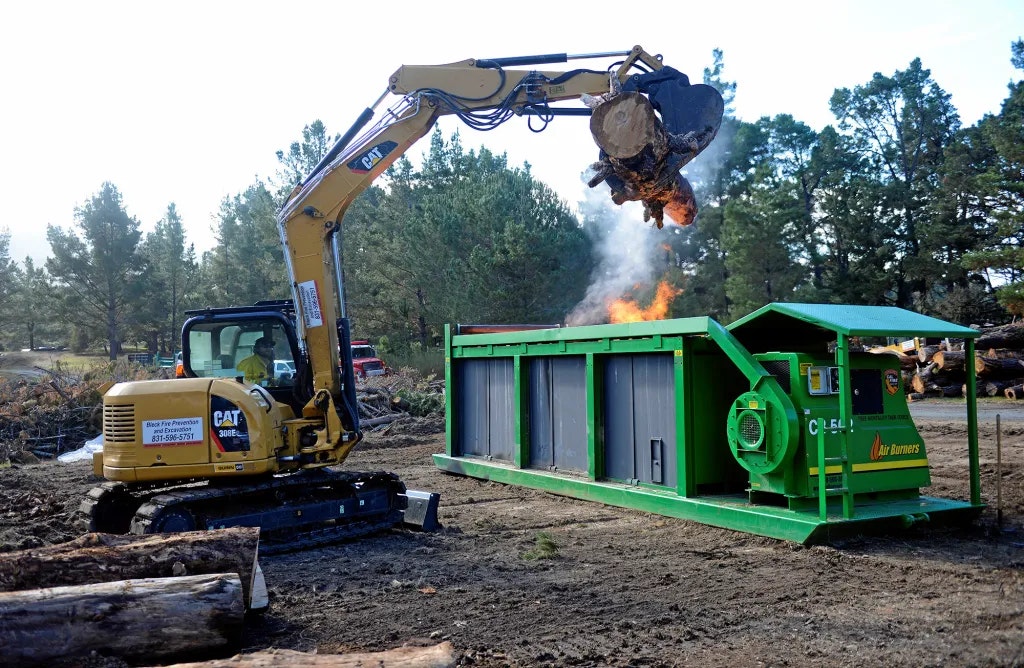Air Curtain Incinerator
An air curtain incinerator (ACI), also called air curtain burner, is a controlled form of open burning; specifically, the incerineration of clean lumber, wood waste, and yard waste. ACI technology provides efficient alternatives to forest fuel management and wildfire mitigation efforts while drastically reducing the particulate matter (PM) generated.

ACI reducing particulate matter
The main operating principle of an ACI is to blow high-velocity air (curtain) across an open, intergrated combustion chamber (fire box) typically powered by a diesel engine that must meet the cleanest Tier 4 engine standards. The curtain of air serves to increase the residence time of exhaust gases, and in doing so decreases the quanitity of particulate matter emitted. Through proper management of air flow and fuel feed rate, operation of the device may also reduce emissions of CO and NOx resulting in opacities under 10% per EPA Method 9 Testing, as compared to open burning which can typically run at 80% to 100% opacity.

What can I burn?
Incinerators which burn less than 35 tons per day of the materials listed below which are collected from the general public and from residential, commercial, institutional, and industrial sources, are required only to meet the requirements §§ 60.2970 through 60.2974 per 40 CFR 60 Subpart EEEE.
100% wood waste
100% clean lumber
100% yard waste
100% mixture of only wood waste, clean lumber, or yard waste
Wood waste examples:
- Trees
- Tree stumps
- Tree limbs
- Bark
- Sawdust
- Chips
- Shavings
- Pallets
- Lumber not treated with chemicals
Yard waste examples:
- Grass
- Bushes
- Shrubs
- Clippings
What is required?
NCUAQMD requires a Stationary Source Permit to operate ACIs. In addition, if your ACI is located within 1,000 feet of a smoke sensitive receptor, a burn authorization by NCUAQMD Burn Program Coordinator is required daily. District Rule 101 and 206 define a sensitive receptor as "Any Class 1 Area and/or any other areas deemed to be sensitive by APCO including, but not limited to preschools and day centers, K-12 schools, senior retirement housing, and hospitals".
Permittees are required to notify the District prior to moving the unit from one location to another. As part of the notification, the permittee shall provide information comparable to that required under the smoke management component of the District's open burning program.
District Rules that prohibit open burning on a "no burn day" do not apply to ACIs.
You can find NCUAQMD Stationary Source Permit Application Form 1300 Authority to Construct, 1301 Internal Combustion Engine, and more here.
Additional local, state and federal rules and regulations may apply.
If you have additional questions or require further assistance, please contact District staff at (707) 443-3093 or support@ncuaqmd.org .
Additional resources and FAQ
ACI are subject to 40 CFR 60 Subpart EEEE Standards of Performance for Other Solid Waste Incineration Units.
§60.2885 Does this subpart apply to my incineration unit?
§60.2886 What is a new incineration unit?
§60.2971 What are the emission limitations for air curtain incinerators that burn only wood waste, clean lumber, and yard waste?
§60.2972 How must I monitor opacity for air curtain incinerators that burn only wood waste, clean lumber, and yard waste?
§60.2973 What are the recordkeeping and reporting requirements for air curtain incinerators that burn only wood waste, clean lumber, and yard waste?
